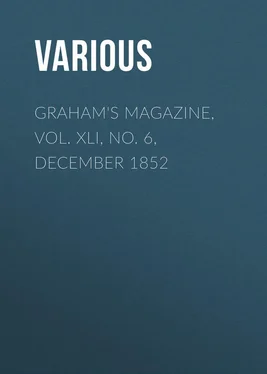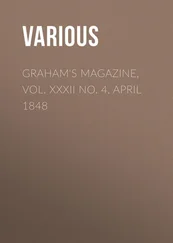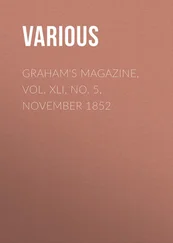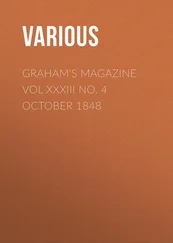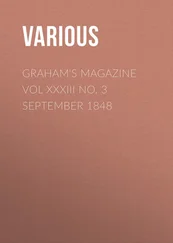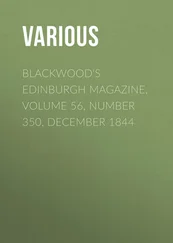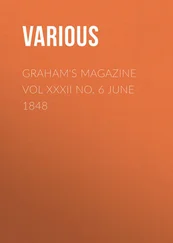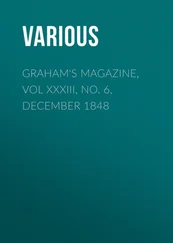Various - Graham's Magazine, Vol. XLI, No. 6, December 1852
Здесь есть возможность читать онлайн «Various - Graham's Magazine, Vol. XLI, No. 6, December 1852» — ознакомительный отрывок электронной книги совершенно бесплатно, а после прочтения отрывка купить полную версию. В некоторых случаях можно слушать аудио, скачать через торрент в формате fb2 и присутствует краткое содержание. Издательство: Иностранный паблик, Жанр: periodic, literature_19, foreign_edu, на английском языке. Описание произведения, (предисловие) а так же отзывы посетителей доступны на портале библиотеки ЛибКат.
- Название:Graham's Magazine, Vol. XLI, No. 6, December 1852
- Автор:
- Издательство:Иностранный паблик
- Жанр:
- Год:неизвестен
- ISBN:нет данных
- Рейтинг книги:3 / 5. Голосов: 1
-
Избранное:Добавить в избранное
- Отзывы:
-
Ваша оценка:
- 60
- 1
- 2
- 3
- 4
- 5
Graham's Magazine, Vol. XLI, No. 6, December 1852: краткое содержание, описание и аннотация
Предлагаем к чтению аннотацию, описание, краткое содержание или предисловие (зависит от того, что написал сам автор книги «Graham's Magazine, Vol. XLI, No. 6, December 1852»). Если вы не нашли необходимую информацию о книге — напишите в комментариях, мы постараемся отыскать её.
Graham's Magazine, Vol. XLI, No. 6, December 1852 — читать онлайн ознакомительный отрывок
Ниже представлен текст книги, разбитый по страницам. Система сохранения места последней прочитанной страницы, позволяет с удобством читать онлайн бесплатно книгу «Graham's Magazine, Vol. XLI, No. 6, December 1852», без необходимости каждый раз заново искать на чём Вы остановились. Поставьте закладку, и сможете в любой момент перейти на страницу, на которой закончили чтение.
Интервал:
Закладка:
In 1775, when he was twenty-two years old, he received a premium from the Society for the Encouragement of Arts and Manufactures for a cut of “the Huntsman and the Old Hound,” which was first printed in an edition of Gay’s Fables, published by T. Saint, Newcastle, 1779 – a fac-simile of which is given below.
Although this juvenile engraving of the great master in no respect approaches the greatest, or even the average, of his mature works, it yet exhibits great talent and greater promise. The whole later tendency of wood-engraving, such as it was, had been toward conventional method, not toward the study and imitation of nature; and here at once, in his earliest success, we find the learner leaving all rules and precepts behind him, and dashing at once into the bold, free, and irregular imitations of nature, by which he was thereafter to achieve a reputation, create a school, and redeem a noble art from the disrepute into which it had fallen; not – as some foolishly have asserted – to revive a lost or forgotten art; for wood-cutting never had been, even in the worst times, disused , but only degraded from its high estate and abused to base purposes.
It must be evident that within the limits of an article, such as this, it must be impossible to enter fully into the merits and peculiarities of all the wood-engravers of four centuries; when at the present day alone there are living more than twenty, to each of whom more than an equal space were fairly due, if we but had the space to bestow in proportion to their deserts. As it is, even on Bewick, greatest, in our opinion, most original, most truthful to nature, and least a mannerist of all who have succeeded or preceded him, we can dwell long enough only to speak of him generally as the founder of the modern school, superior in delineation of texture, in force, in spirit, and in the true feeling and genius of the art of wood-cutting, to all the world beside. To those who are acquainted with his “British Birds,” we need only refer to his “woodcock” and his “partridge,” more especially, in justification of our unqualified praise and admiration; to those who are not, we can only give our earnest advice to become acquainted with them as soon as may be. Bewick had many scholars and pupils, who have brought down his reputation and much of his skill to the present day. Mr. Harvey, one of his most eminent successors, long considered his best pupil, has given up engraving for designing, still maintaining high character for ability; but, though a man of unquestioned talent, he is rather too much of a mannerist greatly to delight ourselves. The delicious foliage of Linton, king of all modern artists, is known to all our readers from the fine wood-cuts in the illustrated London papers; as are the traits and characteristics of Thompson, Foster, and half a dozen others, although their names may not be so familiar as their works. Beyond all doubt, the English school of wood-cutting, whether for loose, sketchy, landscape, or elaborate portraiture, is now the finest, freest, simplest, and most natural in the world; the French excel in a sort of bold pen and inky style of character and caste delineation – but it is national, not universal – tricky, not artistical, and lacking the “touch of nature which makes the whole world kin.”
No country has, however, made such wonderful strides in this art as America; for twenty years ago scarce twenty wood-engravings were published annually in America; now we should be afraid to say how many times twenty thousand.
Then, there were, to the best of our memory, but two wood-cutters of any great note or merit – certainly in New York, we believe in America. Dr. Alex’r. Anderson, supposed to be the first who produced any thing worthy of note in this profession, commenced the business, which he still pursues, in 1798 or 1799. Mr. J. A. Adams was the next, who applied himself to the art in 1826. He has now retired, it is understood, on a handsome competency earned by his talent and industry; chiefly, it is said, through his engagement on Harper’s illustrated Bible, a work which owes its celebrity to its prestige, as being the first thing of the kind issued in the United States, and by no means to its merits as a work of art. When issued, in the opinions of those who knew, it was barely tolerable for this country, in which the art was nearly unknown; were it to appear now, it would be merely contemptible.
Not to be over boastful of our own columns, we do not fear to challenge comparison between the generic cuts of game, which have appeared in Graham, within the last two years, from the gravers of Devereux and Brightly, against any thing of their character since the days of Bewick. The cuts of Orr – to whom we had intended to allude more fully – in this paper, as well as those of Devereux generally, prove what we shall do hereafter. But want of space, in this number, circumscribes much complimentary mention of these and many other artists.
Note. – The head and tail-pieces of this article, without assuming to be splendid or unusual specimens of art, are given as characteristic examples of the modern style in the treatment of foliage and architecture.
RIVERS
Many rivers are subject to a considerable elevation of the level of their waters. This is periodical or irregular in its occurrence, according to the nature of the producing cause. Casual temporary floodings, as the effect of extraordinary rains, are common to the streams of most countries, and sometimes occasion great changes of the surface, and destruction of life and property. One of the most remarkable instances of this kind in modern times, occurred on the 4th of August, 1829, in Scotland, when the Nairn, Spey, and Findhorn rose above their natural boundaries, and spread a devastating deluge over the surrounding country. The rain which produced this flood fell chiefly on the Monadhleadh Mountains, where the rivers in question have their feeders, situated between the south of Loch Ness and the group of the Cairngorums. Sir Thomas Dick Lauder, in his interesting account of this inundation, considers the westerly winds, which prevailed for some time previously, after a season of unusual heat, to have produced a gradual accumulation of vapor, somewhere north of our island; and the column being suddenly impelled by a strong north-easterly blast, it was driven toward the south-west, till arrested in its course by the lofty mountains upon which it discharged itself in torrents perfectly unexampled. The rain fell occasionally in heavy drops, but was for the most part broken by the blast into extremely minute particles, so thick that the very air itself seemed to be descending in one mass of water upon the earth. It deluged every house whose windows were exposed to the south-east. The lesser animals, the birds, and especially game of all kinds, were destroyed in great numbers, by the rain alone; and the mother partridge, with her progeny and mate, were found chilled to death amidst the drenching wet. At Huntly Lodge, according to an accurate observation, between five o’clock of the morning of the 3d of August and the same hour of the succeeding day there fell 3¾ inches of rain, or about one-sixth of our annual allowance of rain descended there in twenty-four hours. This was at a considerable distance from the mountains – the central scene of the rain – where its quantity must have been prodigiously greater, sufficient to account for the tremendous flood that followed, far exceeding in its rise, duration, and havoc, any other that ever affected the same locality. The Findhorn and Spey assumed the appearance of inland seas; and, when the former began to ebb, a fine salmon was driven ashore and captured at an elevation of fifty feet above its ordinary level. Most of the rivers of the temperate zones are subject to these irregular floodings from the same cause, especially those which take their rise in high mountain regions, the St. Lawrence being the most remarkable exception, the level of which is not affected by either rains or drought. The vast lakes from which this river issues furnish its channel with an inexhaustible supply of water, and present a surface too extensive to be sensibly elevated by any extraordinary rains. A strong westerly wind, however, will affect the level of the St. Lawrence, and occasion a rise of six feet in the waters to the eastern extremity of Lake Erie. An easterly wind also upon the Orinoco will check its current, elevate the upper part of the stream, and force its waters into the channels of its tributaries, giving them a backward flow, and causing them to be flooded; and a northerly wind will drive the Baltic up the mouths of the Oder, and raise its level for a considerable distance. In a similar manner, the Neva rises when a strong wind blows from the Gulf of Finland; and that occurrence – taking place coincidently with high water and the breaking up of the ice, would create an inundation sufficient to drown the whole population of St. Petersburg, and convert that brilliant capital, with all its sumptuous palaces, into a chaotic mass of ruins. We have the materials of this statement from M. Kohl. The Gulf of Finland runs to a point as it approaches the mouth of the Neva, where the most violent gales are always those from the west; so that the mass of waters on such occasions is always forcibly impelled toward the city. The islands forming the delta of the Neva, on which St. Petersburg stands, are extremely low and flat; and the highest point in the city is probably not more than twelve or fourteen feet above the average level of the sea. A rise of fifteen feet is therefore enough to place all St. Petersburg under water, and a rise of thirty feet is enough to drown almost every human being in the place. Hence the inhabitants of the capital are in constant danger of destruction at the period referred to, and can never be certain that the 500,000 of them may not, within the next twenty-four hours, be driven out of their houses to find, in multitudes of instances, a watery grave. This is not a chimerical danger; for, during its short continuance, the city of the Czar has experienced some formidable inundations. The only hope of this apparently doomed city is that the three circumstances may never be coincident, namely, high water, the breaking up of the ice, and a gale of wind from the west. It is nevertheless true, that the wind is very often westerly during spring, and the ice floating in the Neva and the Gulf of Finland is of a bulk amply sufficient to oppose a formidable obstacle to the egress of the water; so that it will not be surprising if St. Petersburg, after suddenly rising like a meteor from the swamps of Finland, should still more suddenly be extinguished in them.
Читать дальшеИнтервал:
Закладка:
Похожие книги на «Graham's Magazine, Vol. XLI, No. 6, December 1852»
Представляем Вашему вниманию похожие книги на «Graham's Magazine, Vol. XLI, No. 6, December 1852» списком для выбора. Мы отобрали схожую по названию и смыслу литературу в надежде предоставить читателям больше вариантов отыскать новые, интересные, ещё непрочитанные произведения.
Обсуждение, отзывы о книге «Graham's Magazine, Vol. XLI, No. 6, December 1852» и просто собственные мнения читателей. Оставьте ваши комментарии, напишите, что Вы думаете о произведении, его смысле или главных героях. Укажите что конкретно понравилось, а что нет, и почему Вы так считаете.
